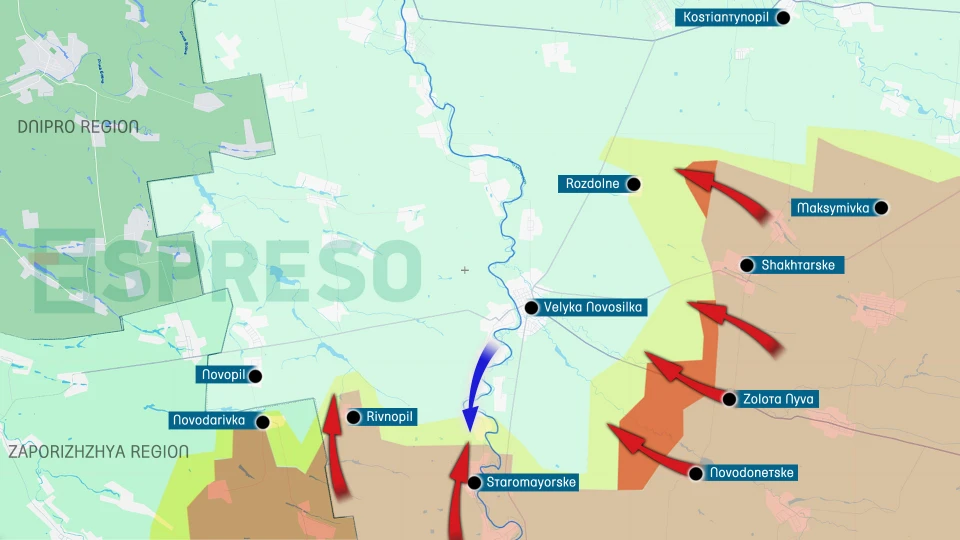
Emergency Ukraine-NATO meeting to address Russia's Oreshnik system. Serhiy Zgurets' column
On November 26, Ukraine-NATO will discuss Russia's Oreshnik missile which struck Dnipro. Ukraine will stress the need to strengthen its missile defense shield
Night strikes on targets in Russia
On November 25, the Ukrainian Armed Forces attacked a number of Russian targets in the Bryansk, Kaluga and Kursk regions with attack drones and missile weapons. The Ukrainian Armed Forces' General Staff confirmed the successful strike on an oil depot in the Kaluga region, which was not burning as brightly as it is now. This base is involved in the logistics of the Russian army.
Among the targets was a military airfield in the Kursk region, struck by ATACMS missiles - the Khalino airfield. Videos show explosions and detonation of submunitions, as cluster ATACMS were used. In some footage, the Russians attempt to counter ATACMS strikes using S-400 systems, but without success. It’s likely the strikes targeted not only the S-400 positions but also the parking areas for Su-30 bombers. While we don’t know how many bombers were present, it’s clear they are used for deploying UMPCs (gliding bombs). Had such strike capabilities been available earlier, Russia's losses at such airfields would have been significantly higher. However, we’ll wait for satellite images before drawing conclusions.
Another target struck by Ukrainian drones was an enterprise called NGO Typhoon, located in the Kaluga region. While it is generally known as a manufacturer of electronic equipment for military purposes, it has emerged that this company plays a significant role in producing control and communication centers for the Bal anti-ship missile systems with Kh-35 missiles, as well as for the Bastion anti-ship system with Oniks missiles.
This company also manufactures the Monolith-B reconnaissance station, and these systems were used to attack Ukrainian Black Sea cities. This enterprise is also the final manufacturer of the Rubizh-ME missile system, the export version. We understand that the target is important enough to destroy. We do not yet know the results of the strikes on this enterprise, but the distance of 290 kilometers is quite achievable for repeated attacks by Ukrainian drones on this facility.
NATO-Ukraine Council
An emergency meeting of the NATO-Ukraine Council is to be held in Brussels to discuss Russia's use of the new or old Rubezh-Oreshnik-Kedr medium-range missile that hit Ukraine's Dnipro city. The NATO-Ukraine Council is meeting at Kyiv's request, and it is likely that Ukraine's representatives will emphasize the need to strengthen the missile shield over Ukraine.
There are several possible scenarios. The first involves using SM-3 missiles from the U.S. Aegis missile defense system, which has bases in Poland and Romania. The second scenario suggests that Kyiv may emphasize acquiring the THAAD system. This American system intercepts medium-range ballistic missiles in their terminal phase at ranges up to 200 km and altitudes of up to 150 km, offering capabilities far superior to the Patriot system. Ukraine had already requested a THAAD battery from the U.S. in March, but the request did not yield positive results.
The U.S. has only seven THAAD batteries, three of which are located outside the country. The issue is that it’s a very expensive system, ranging from $2 billion to $3 billion per battery, with each missile costing around $20 million. However, I’m confident that Ukraine will raise the issue of securing new air defense systems. We’ll wait for the response from the partners. This topic will be continued following the Ukraine-NATO Council meeting.
Frontline update
The situation on the front line has escalated in recent days, with the intensity of attacks significantly increasing. In fact, there have been over 200 Russian attacks per day. Of these, 120 occurred in the Pokrovsk and Kurakhove directions. Additionally, Russian forces have intensified their operations in the south, particularly around Velyka Novosilka, Donetsk region.

However, Russian forces are also focusing their efforts on the Zaporizhzhia direction. Velyka Novosilka is currently under attack from several directions. Russian forces are trying to exert pressure from the east and influence the logistics connection that supplies Velyka Novosilka. There are also several other areas where Russia is trying to advance.
Serhiy Leshchenko, commander of the mortar battery of the 4th operational battalion of the Spartan brigade in the Zaporizhzhia direction, reported that Russian troops continue to actively use small assault groups and conduct reconnaissance by combat against Ukrainian positions. On November 24, there were several such Russian assault attempts. On November 25, a group of 12 Russian soldiers attempted to storm, but all were destroyed by accurate Ukrainian fire. Over the past month, the Russian actions have not changed; they continue to build up their forces and try to break through Ukrainian defenses. Ukrainian defenders are delivering a powerful response, utilizing artillery, mortars, and drones.
The officer noted that a typical day in a mortar battalion consists of physical exercises, as the mortar itself is a heavy weapon. For example, a 120 mm mortar weighs 12 kg. A mortar launcher's day off is designed so that the day at the position is easy and safe.
The commander of the mortar battery added that, by the third year of the war, there were significant changes in the frontline situation as well as in combat methods and tactics. Mavic and FPV drones have taken the lead in precision, even playing a bigger role than artillery or infantry. When Russian infantry groups are spotted, reconnaissance alerts, and immediately FPV drones and Mavic bombers are deployed to drop munitions. These tools effectively and precisely eliminate Russian infantry. Mortarmen now play a role in containment, destroying enemy groups rather than individual soldiers. Mortar batteries slow down the Russian advance, while drone pilots target specific enemy groups and create conditions for their retreat.
The serviceman noted that the Russians are quickly learning and should never be underestimated. There are frequent cases where they send infantry with no specific purpose, just to be destroyed by Ukrainian forces, allowing them to locate Ukraine's mortar positions. The soldiers from the 4th operational battalion of the Spartan brigade have been fighting for years and know how to properly camouflage and build engineering fortifications. For example, it’s crucial to seal the shelters properly to prevent heat leakage, as Russian drones switch to night mode at night and can detect all heat signatures, sometimes even identifying mice.
Leshchenko said that the Russians also know how to disguise themselves well and use cloaks that seal in heat, so it is sometimes very difficult to detect them at night. When the Russian infantry wear such cloaks at night, they are invisible to Ukrainian night "birds". But Ukrainian pilots are all experienced, so they manage to detect Russian soldiers both at night and during the day. In addition, the Russians are digging in very well, but we also know how they carry out such engineering activities. That is, as soon as we see some garbage or camouflage netting, we realize that some work is being done there. We can shoot disturbing fire there, so that the enemy can detect themselves, perhaps panic and run from cover.
The mortar battery of the 4th operational battalion of the Spartan Brigade holds the most difficult defense lines, has performed this task before and will continue to do so.
- News












































